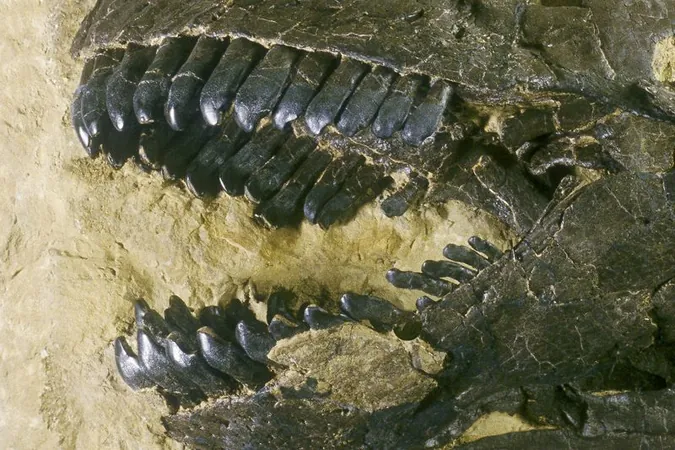
Unlocking the Secrets of Our Planet's Past with Dinosaur Teeth
2025-08-26
Author: Benjamin
Ancient Teeth, Modern Discoveries
Though dinosaurs have been extinct for millions of years, their teeth are revealing vital secrets about Earth’s ancient atmosphere. Researchers from the Universities of Göttingen, Mainz, and Bochum have pioneered a groundbreaking study showing that the tough enamel of dinosaur teeth can contain chemical clues dating back to the Jurassic and Cretaceous periods.
Reading the Air Through Enamel
Using oxygen isotopes embedded in these fossils, scientists are able to reconstruct past atmospheric conditions without solely depending on marine sediments or soil samples. This innovative technique offers a unique insight into carbon dioxide levels and the global plant health during the age of dinosaurs.
A Snapshot Captured in Calcium
The research focuses on a specific isotope anomaly, Δ¹⁷O, linked to the oxygen isotopes inhaled by these ancient beasts. As dinosaurs breathed in, their bodies absorbed these isotopes, which then became locked in the growing enamel of their teeth. This robust material remains chemically stable, preserving these atmospheric signatures for millions of years.
High CO2 Levels in Prehistoric Times
The findings are astonishing: during the Late Jurassic period, CO2 levels reached about 1,200 parts per million (ppm)—a staggering three times higher than preindustrial levels! Even in the Late Cretaceous, CO2 levels hovered around 750 ppm, still roughly double what we see today. This aligns closely with established studies, boosting confidence in the accuracy of this new approach.
Extreme Peaks Linked to Volcanic Activity
Some samples revealed even more shocking concentrations. A T. rex tooth indicated nearly 1,800 ppm, while one Jurassic sauropod suggested an extreme 3,000 ppm! Such spikes could be tied to significant volcanic events, like the catastrophic eruptions of the Deccan Traps, which scientists believe triggered drastic climate shifts.
Navigating Methodology Challenges
While promising, the enamel isotope method does have its uncertainties. Identifying the productivity of ancient ecosystems complicates direct calculations of CO2 levels. The interplay of CO2 concentration and plant productivity means researchers must make informed assumptions, which introduces variability into their estimates.
Plant Life Thriving in a Greenhouse World
Interestingly, this research enables scientists to gauge global plant productivity during the Mesozoic. Findings suggest that ecosystems back then might have been more productive than those today. Late Jurassic vegetation could have surpassed modern growth levels by 20%, and Late Cretaceous productivity could be twice as much!
Deciphering Local Influences
One key challenge is distinguishing local conditions from global atmospheric trends. For example, unusually high CO2 readings from a T. rex tooth might reflect localized evaporation impacts, while more stable readings from other samples suggest genuine atmospheric changes.
A New Era in Paleoclimate Research
Previous climate reconstructions primarily relied on indirect evidence from ancient seas and soils. The use of enamel provides a direct record from terrestrial animals, helping scientists develop a comprehensive view of our planet’s climate history.
Unlocking Earth’s Climate Dynamics
Lead researcher Dr. Dingsu Feng expressed enthusiasm about this breakthrough: "Our method unveils a completely new perspective on Earth's past. It allows us to investigate the early atmosphere and ancient plant activity—critical pieces for understanding long-term climate behavior." He emphasized that this research finally allows us to interpret the messages encoded in dinosaur teeth from over 150 million years ago.
Implications for Today’s Climate Debate
This new method not only enriches our understanding of ancient climates but also underscores the rapid impacts of CO2 fluctuations—lessons that carry significant weight in today’s discussions about climate change. Understanding how ecosystems nurtured gigantic dinosaurs against a backdrop of varying CO2 can dramatically inform our current climate models.
These groundbreaking findings are set to be published in the journal PNAS, marking a pivotal advancement in paleoclimate studies.









 Brasil (PT)
Brasil (PT)
 Canada (EN)
Canada (EN)
 Chile (ES)
Chile (ES)
 Česko (CS)
Česko (CS)
 대한민국 (KO)
대한민국 (KO)
 España (ES)
España (ES)
 France (FR)
France (FR)
 Hong Kong (EN)
Hong Kong (EN)
 Italia (IT)
Italia (IT)
 日本 (JA)
日本 (JA)
 Magyarország (HU)
Magyarország (HU)
 Norge (NO)
Norge (NO)
 Polska (PL)
Polska (PL)
 Schweiz (DE)
Schweiz (DE)
 Singapore (EN)
Singapore (EN)
 Sverige (SV)
Sverige (SV)
 Suomi (FI)
Suomi (FI)
 Türkiye (TR)
Türkiye (TR)
 الإمارات العربية المتحدة (AR)
الإمارات العربية المتحدة (AR)